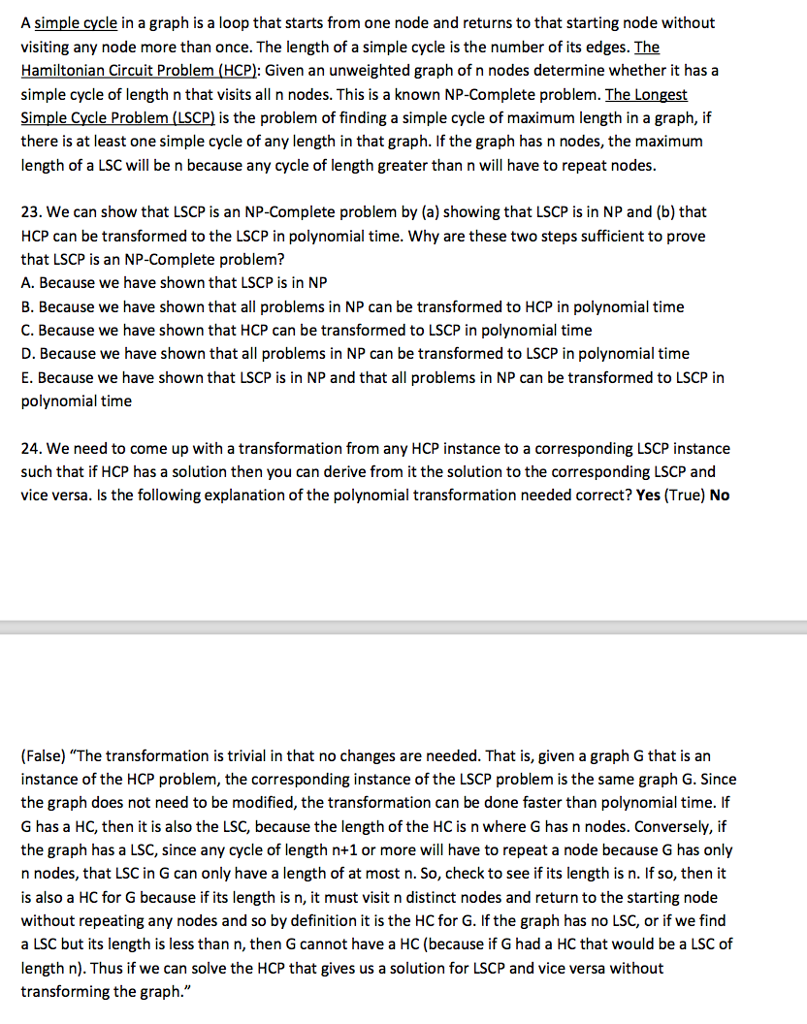
A simple cycle in a graph is a loop that starts from one node and returns to that starting node without visiting any node more than once. The length of a simple cycle is the number of its edges. The Hamiltonian Circuit Proble (HCP: Given an unweighted graph of n nodes determine whether it has a simple cycle of length n that visits all n nodes. This is a known NP-Complete problem. The Longest Simple Cycle Problem (LSCP) is the problem of finding a simple cycle of maximum length in a graph, if there is at least one simple cycle of any length in that graph. If the graph has n nodes, the maximum length of a LSC will be n because any cycle of length greater than n will have to repeat nodes 23. We can show that LSCP is an NP-Complete problem by (a) showing that LSCP is in NP and (b) that HCP can be transformed to the LSCP in polynomial time. Why are these two steps sufficient to prove that LSCP is an NP-Complete problem? A. Because we have shown that LSCP is in NP B. Because we have shown that all problems in NP can be transformed to HCP in polynomial time C. Because we have shown that HCP can be transformed to LSCP in polynomial time D. Because we have shown that all problems in NP can be transformed to LSCP in polynomial time E. Because we have shown that LSCP is in NP and that all problems in NP can be transformed to LSCP in polynomial time 24. We need to come up with a transformation from any HCP instance to a corresponding LSCP instance such that if HCP has a solution then you can derive from it the solution to the corresponding LSCP and vice versa. Is the following explanation of the polynomial transformation needed correct? Yes(True) No (False) "The transformation is trivial in that no changes are needed. That is, given a graph G that is an instance of the HCP problem, the corresponding instance of the LSCP problem is the same graph G. Since the graph does not need to be modified, the transformation can be done faster than polynomial time. If G has a HC, then it is also the LSC, because the length of the HC is n where G has n nodes. Conversely, if the graph has a LSC, since any cycle of length n+1 or more will have to repeat a node because G has only n nodes, that LSC in G can only have a length of at most n. So, check to see if its length is n. If so, then it is also a HC for G because if its length is n, it must visit n distinct nodes and return to the starting node without repeating any nodes and so by definition it is the HC for G. If the graph has no LSC, or if we find a LSC but its length is less than n, then G cannot have a HC (because if G had a HC that would be a LSC of length n). Thus if we can solve the HCP that gives us a solution for LSCP and vice versa without transforming the graph." A simple cycle in a graph is a loop that starts from one node and returns to that starting node without visiting any node more than once. The length of a simple cycle is the number of its edges. The Hamiltonian Circuit Proble (HCP: Given an unweighted graph of n nodes determine whether it has a simple cycle of length n that visits all n nodes. This is a known NP-Complete problem. The Longest Simple Cycle Problem (LSCP) is the problem of finding a simple cycle of maximum length in a graph, if there is at least one simple cycle of any length in that graph. If the graph has n nodes, the maximum length of a LSC will be n because any cycle of length greater than n will have to repeat nodes 23. We can show that LSCP is an NP-Complete problem by (a) showing that LSCP is in NP and (b) that HCP can be transformed to the LSCP in polynomial time. Why are these two steps sufficient to prove that LSCP is an NP-Complete problem? A. Because we have shown that LSCP is in NP B. Because we have shown that all problems in NP can be transformed to HCP in polynomial time C. Because we have shown that HCP can be transformed to LSCP in polynomial time D. Because we have shown that all problems in NP can be transformed to LSCP in polynomial time E. Because we have shown that LSCP is in NP and that all problems in NP can be transformed to LSCP in polynomial time 24. We need to come up with a transformation from any HCP instance to a corresponding LSCP instance such that if HCP has a solution then you can derive from it the solution to the corresponding LSCP and vice versa. Is the following explanation of the polynomial transformation needed correct? Yes(True) No (False) "The transformation is trivial in that no changes are needed. That is, given a graph G that is an instance of the HCP problem, the corresponding instance of the LSCP problem is the same graph G. Since the graph does not need to be modified, the transformation can be done faster than polynomial time. If G has a HC, then it is also the LSC, because the length of the HC is n where G has n nodes. Conversely, if the graph has a LSC, since any cycle of length n+1 or more will have to repeat a node because G has only n nodes, that LSC in G can only have a length of at most n. So, check to see if its length is n. If so, then it is also a HC for G because if its length is n, it must visit n distinct nodes and return to the starting node without repeating any nodes and so by definition it is the HC for G. If the graph has no LSC, or if we find a LSC but its length is less than n, then G cannot have a HC (because if G had a HC that would be a LSC of length n). Thus if we can solve the HCP that gives us a solution for LSCP and vice versa without transforming the graph







